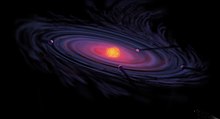Formation
Main article: Nebular hypothesis
It is not known with certainty how planets are formed. The prevailing theory is that they are formed during the collapse of a nebula into a thin disk of gas and dust. A protostar forms at the core, surrounded by a rotating protoplanetary disk. Through accretion (a process of sticky collision) dust particles in the disk steadily accumulate mass to form ever-larger bodies. Local concentrations of mass known as planetesimals form, and these accelerate the accretion process by drawing in additional material by their gravitational attraction. These concentrations become ever denser until they collapse inward under gravity to form protoplanets.[65] After a planet reaches a diameter larger than the Earth's moon, it begins to accumulate an extended atmosphere, greatly increasing the capture rate of the planetesimals by means of atmospheric drag.[66] An artist's impression of protoplanetary disk

0 comments:
Post a Comment